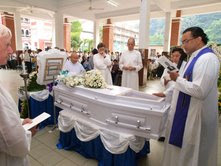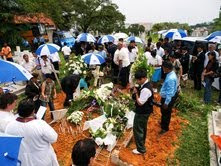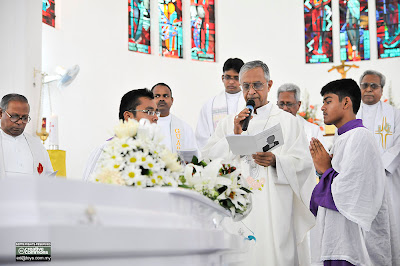
I wrote this piece below in 2005 because the Merdeka Stadium is close to my heart.
As we celebrate our 52nd Merdeka on Monday, I felt that this piece should see light again for the benefit of those who might have missed it four years ago.
I will update the article as things have changed in the last four years. For one, I lost my father two years ago.
In a way, this article is dedicated to him, for he was the one who introduced me to Merdeka Stadium, which later became very much part of my life as a student, a fan and finally, a sports journalist .
I miss him, especially during Merdeka, because he used to tell us stories of the Japanese Occupation where he was a Hindi interpreter, then his stint with the Indian National Army (INA), the various places he was in Malaya at different stages of his life which included Port Dickson, Johor, Beruas, Malim Nawar, Ipoh, Bagan Serai, Nibong Tebal, Tampin and Kuala Lumpur.
He also had stories to tell about India. Although he was born in Johor on 21st Oct 1923, my grandfather decided to send my father and his elder brother together with my grandmother to India,because of financial difficulties. My grandmother came back to Johor after sometime leaving her two sons there to brought up by her in-laws.
My dad and his brother returned to Malaya some years later and headed to Taiping, before moving with my grandfather from one place to another.
My father also told us stories of Merdeka and about life which was so much simpler, harmonious and peaceful.
I miss the recollections and cherish those moments, for I dearly miss them.
Life is always that way, one misses someone much more, when the person is no longer around.
For me, it is not only my father that I miss, but my mother too, who passed away in 1997. I miss them both very much especially since I do not have anyone to call dad or mum.
For those who still have their parents, cherish these moments and bear with their moods and grudges, because it will be too late when you start missing them.
My consolation is that, I did everything I could for my parents, although on the hindsight, I feel that I could have done more.
These days when I look into the eyes of my son and daughter, it reminds me of how my dad and mum would look at me.
This repeated story is in memory of my parents.
I have also attached my television interview on the 50th Merdeka anniversary.
GLORIOUS PAST OF MERDEKA STADIUM
THE nation was born on sporting grounds at the stroke of midnight on Aug 31, 1957, at the Selangor Padang (now known as Dataran Merdeka) and at Merdeka Stadium, where the proclamation of independence was held the next morning.

Such is the rich history of sports in this country and as we celebrated our 48th year (2005) of independence on Wednesday, one could not help but look back at yesteryears, when sports enjoyed more glory and accorded higher status.
After all, soccer and a few other sports were part of the legacies left behind by the British and have been part of Malaysian culture since the1920s.
It was Tunku Abdul Rahman Al-haj's vision which saw Merdeka Stadium built in record time and officially declared open on Aug 30, 1957, in time for the Merdeka celebrations the following morning, where more than 10,000 attended the parade.

And it was Tunku's vision which saw the birth of the Merdeka soccer tournament that soon became a prestigious event in Asia. The Asian Youth tournament two years later was also the Tunku's brainchild.
Malaya became champions of the Merdeka tournament in 1958 and several times thereafter.
And it was not only in soccer that Malaysia excelled in, but also in badminton where Wong Peng Soon and Eddy Choong dominated the All-England badminton championships from 1950 to 1957, following which Tan Aik Huang won it again in 1966.
Malaysia then had athletes like Datuk Dr M. Jegathesan and Isthiaq Mubarak reaching great heights in the Olympics, and the hockey team that reached the World Cup semi-finals in 1975 at Merdeka Stadium.
While the nation have grown by leaps and bounds in all other areas, it is sad that in sports, despite all the modern facilities, technology, funds and rewards that are readily available, has deteriorated.
So what has gone wrong with Malaysian sports which started off on such a strong note, but failed to grow in parallel with the nation, but instead has faltered?
Other nations who played second fiddle to us and feared us in the past, are now giants and have attained world-class level.
The biggest problem with Malaysian sports is there is not one weakness or flaw that can be identified which could be rectified.
The ills befalling Malaysian sports have become widespread over the years, and it is really hard to pinpoint the cause in order to provide the antidote.
But probably, the fact that Merdeka Stadium, a historic landmark, was almost reduced to ashes in 2001, should give Malaysians an idea of how much they treasure the memories to emulate those who toil and sweat for their achievements.
And it comes as no surprise that Malaysian sportsmen and women do not display the same passion, spirit, determination, discipline and dedication to strive in the sporting arena.
THE INTERVIEW in the Sports a Nation a Builder series which appeared in TV 3 in 2007
http://www.youtube.com/watch?
For me, my association with Merdeka Stadium started without my knowledge when I was only a year old in 1959.
My parents actually held my first birthday tea-party at the restaurant in the stadium!

No, my parents were not rich, but caretakers of a guest-house, but having been married six months before Merdeka and being part of the celebrations, they probably treasured those moments and wanted me to share the joy and happiness by throwing a party for me there.

I may not have known it then, but that association 46 years ago has virtually "married" me to the stadium. I only realised the tea-party was at Merdeka Stadium, as I grew older and recognised those black-and-white photographs taken then.

Then as a schoolboy, I ran along the Merdeka Stadium bitumen tracks at my school's (St John's Institution) sports day and played in the Selangor Schools U-18 final against La Salle PJ in 1975, which we won.
And how can I forget the 1975 World Cup semi-finals which I watched as a schoolboy?
And from the early 80s, Merdeka Stadium became my regular haunt as a cub reporter covering Razak Cup, Asian Schools, Malaysia Cup and Merdeka tournament soccer matches, in addition to the countless athletics meets, not to mention watching live concerts there, including Eric Clapton's performance.
Millions of other Malaysians will have similar tales to relate, and which will be told for many years to come.
And to think of the disrespect and disregard for the Grand Old Lady, that has been accorded Merdeka Stadium, is indeed scary, not to mention our Father of Independence.
Thanks to Permodalan Nasional Berhad, who had taken over from previous owners United Engineers Malaysia Berhad, and their chairman, Tan Sri Ahmad Sarji Abdul Hamid, a concerted effort has been made to conserve and preserve the stadium.
 The historical Stadium Merdeka here was given the “Award of Excellence” in the 2008 Unesco Asia-Pacific Heritage Awards for Culture Heritage Conservation after successfully being restored to its full glory.
The historical Stadium Merdeka here was given the “Award of Excellence” in the 2008 Unesco Asia-Pacific Heritage Awards for Culture Heritage Conservation after successfully being restored to its full glory.It is disconcerting that Malaysians have gradually been ignoring the value of sports.
Efforts are being made to instil the sporting culture in Malaysians once again, but it is not something which will take place overnight because they must feel the sporting spirit first.
Some may think it is far-fetched to associate Merdeka Stadium with the ills of sports in the country today, but it was where it began for the nation and sports.
And if Malaysians do not value those moments and try to relive them, let alone better them, a part of our history would already have been erased.
Merdeka Stadium is the soul and character of Malaysia and their sporting achievements.
For as long as Merdeka Stadium still exists, it will bear testimony to Malaysia's glorious sporting past.
Maybe, that was why they wanted to reduce the Grand Old Lady to ashes and build skyscrapers instead!
HAPPY MERDEKA!




















































